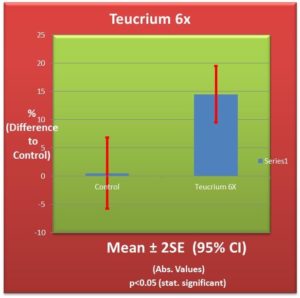Teucrium scorodonia, an herb also known as Wood Sage, has been used less than it deserves in homeopathic medicine for chronic and recurrent inflammations especially in the lower abdomen.
The homeopathic literature recommends it, among other uses, to thin individuals who have bronchitis, nasal or rectal polyps, or in oversensitive children who have been treated with “too much medication”.
Rudolf Steiner, of whose importance and deep wisdom the readers of these blog entries know of well, gives a much deeper picture. His insights have opened a new field of applications of low potency Teucrium of the scorodonia variety.
Let us first give a brief summary of Rudolf Steiner’s views of this herb.
According to him Teucrium scorodonia works on problems of the metabolism, especially of the lower parts of the abdomen, the pelvic region and the reproductive organs, like the uterus, and the prostate, and similar. When the astral body (the soul) is too deeply involved, too “nervous” and “irritable” in its activity in those areas it leads to chronic infections and inflammations. Rudolf Steiner specifically mentions that Teucrium scorodonia heals by pushing this astral body back into the head area and thus ultimately alleviates the symptoms in the lower organism and gives a feeling of additional clarity in the head.
When discussing a female patient R. Steiner mentions that the effect of this plant should be so refreshing on the head that one has feeling as though one would walk through a forest and smell the fresh scent of moss (Interestingly the traditional use of potentized Teucrium is for anosmia-lack of smell). The explanation given is that Teucrium scorodonia reconstitutes the plastic, formative forces in the region of the pelvic area in women as well as in men (and thus frees the astral body from its too strong connection there).
Here are some of the indications that Rudolf Steiner gives to the doctors for treating various patients that he was consulted on:
- Recurrent urinary tract infections with fever
- Edema of the legs accompanied by generalized fatigue and anxiety
- Chronic prostatitis
- Uterine problems, etc.
We can certainly see from the above examples how vital it is to use this remedy in all types of inflammations of the gastro-intestinal/genital/urinary system especially when accompanied with an emotional component (and that happens increasingly frequent these days!). The generally given indication of “bronchitis” are nevertheless a valuable expansion of the idea that Teucrium scorodonia might help in reestablishing a proper balance between the astral body and the etheric body in inflammatory conditions.
Rudolf Steiner uses low potencies in the range of D3 (3X) to D6 (6X).
You can find a very high quality Teucrium scorodonia 6X (same notation as D6) at True Botanica.
We are including a graph below that shows our so called “Kolisko Validation”.
We expose the wheat seeds to the potency of the Teucrium. If the potency would not be any more active than water there should be no difference in the growth to control (water). But there is! We are happy to be able to demonstrate the quality of an anthroposophic remedy.
Ross Rentea MD
